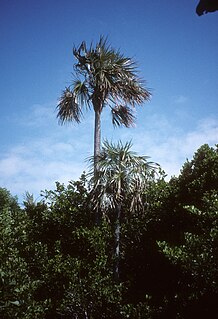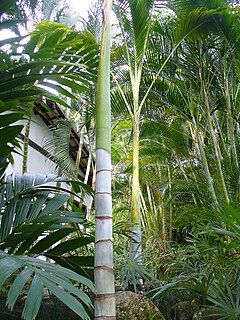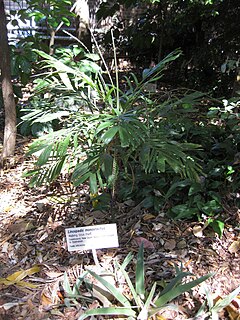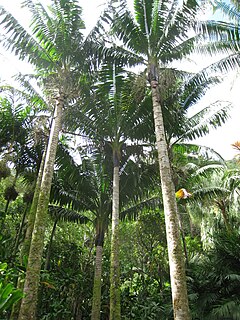
Copernicia is a genus of palms native to South America and the Greater Antilles. Of the known species and nothospecies (hybrids), 22 of the 27 are endemic to Cuba. They are fan palms, with the leaves with a bare petiole terminating in a rounded fan of numerous leaflets. The species are small to medium-sized trees growing to 5–30 m tall, typically occurring close to streams and rivers in savanna habitats.

Coccothrinax is a genus of palms in the family Arecaceae. There are more than 50 species described in the genus, plus many synonyms and subspecies. A new species was described as recently as 2017. Many Coccothrinax produce thatch. In Spanish-speaking countries, guano is a common name applied to Coccothrinax palms. The species are native throughout the Caribbean, the Bahamas, extreme southern Florida and southeastern Mexico, but most of the species are known only from Cuba.

Ceroxylon is a genus of flowering plants in the family Arecaceae, native to the Andes in Venezuela, Colombia, Ecuador, Peru, and Bolivia, known as Andean wax palms.

Clinostigma is a genus of flowering plant in the Arecaceae (palm) family, native to various islands in the western Pacific. It contains the following species:
Cyphosperma is a genus of flowering plants in the family Arecaceae, native to various islands of the Pacific. It contains the following species:

Drymophloeus is a genus of flowering plant in the family Arecaceae. It is native to New Guinea and nearby islands in Samoa and Maluku.

Linospadix is a genus of flowering plant in the family Arecaceae. It is native to New Guinea and Australia.

Neoveitchia is a genus of palm trees. It contains two known species, native to certain islands in the western Pacific:
Physokentia is a genus of flowering plant in the palm family, native to certain islands of the western Pacific.

Ptychosperma is a genus of flowering plant in the family Arecaceae. Most are native to Australia and/or New Guinea, with a few in the Solomon Islands and in Maluku Province of eastern Indonesia. Some have been cultivated abroad as house or garden plants, and reportedly naturalized in certain regions.
Rhopaloblaste augusta is a species of flowering plant in the family Arecaceae. It is found on the Nicobar Islands in the Indian Ocean, part of India. It is also found in Peninsular Malaysia & Singapore, the Moluccas, New Guinea & the Solomon Islands. In lowland rain forest. It is threatened by habitat loss.
Rhopaloblaste is a genus of flowering plant in the family Arecaceae, native to New Guinea, Melanesia and Southeast Asia.

Orania is a genus of the palm tree family Arecaceae, and includes flowering plants native to Southeast Asia, Madagascar, and New Guinea.

Kerriodoxa elegans, the white backed palm, is the only species of palm tree in the genus Kerriodoxa, in the family Arecaceae.
Clinosperma is a palm tree genus in the family Arecaceae.

Cyrtostachys renda, also known by the common names red sealing wax palm and lipstick palm, is a palm that is native to Thailand, Malaysia, Sumatra and Borneo in Indonesia. It is the only species of the genus Cyrtostachys that can be found to the west of the Wallace Line, the faunal boundary separating the biogeographic realms of Asia and Wallacea. Cyrtostachys renda's name is derived from several words: the Greek prefix κυρτό- (cyrto-) meaning bent or curved, the Greek word σταχυς (stachys) meaning "an ear of grain", and "renda" a Malayan Aboriginal word for palm, which happens to be homonymous to the Portuguese word "renda," meaning income.

Borasseae is a tribe in the palm subfamily Coryphoideae. The tribe ranges from southern Africa and Madagascar north through the Arabian Peninsula to India, Indochina, Indonesia and New Guinea. Several genera are restricted to islands in the Indian Ocean. The two largest genera, Hyphaene and Borassus, are also the most widespread.
Jailoloa is a genus of palm, in the subtribe Ptychospermatinae. It has only one currently accepted species, Jailoloa halmaherensis, native to the Moluccas. It only grows on ultramafic soils. The species is currently known only from its type locality in East Halmahera.
Wallaceodoxa is a genus of palm, in the subtribe Ptychospermatinae. It has only one currently accepted species, Wallaceodoxa raja-ampat, native to the Raja Ampat Islands off the Bird's Head Peninsula of New Guinea. It grows on limestone soils.
Pelagodoxeae is a tribe of plants in the family Arecaceae found in Oceania, namely in New Guinea and the Marquesas Islands. The tribe has two monotypic genera, which are:














